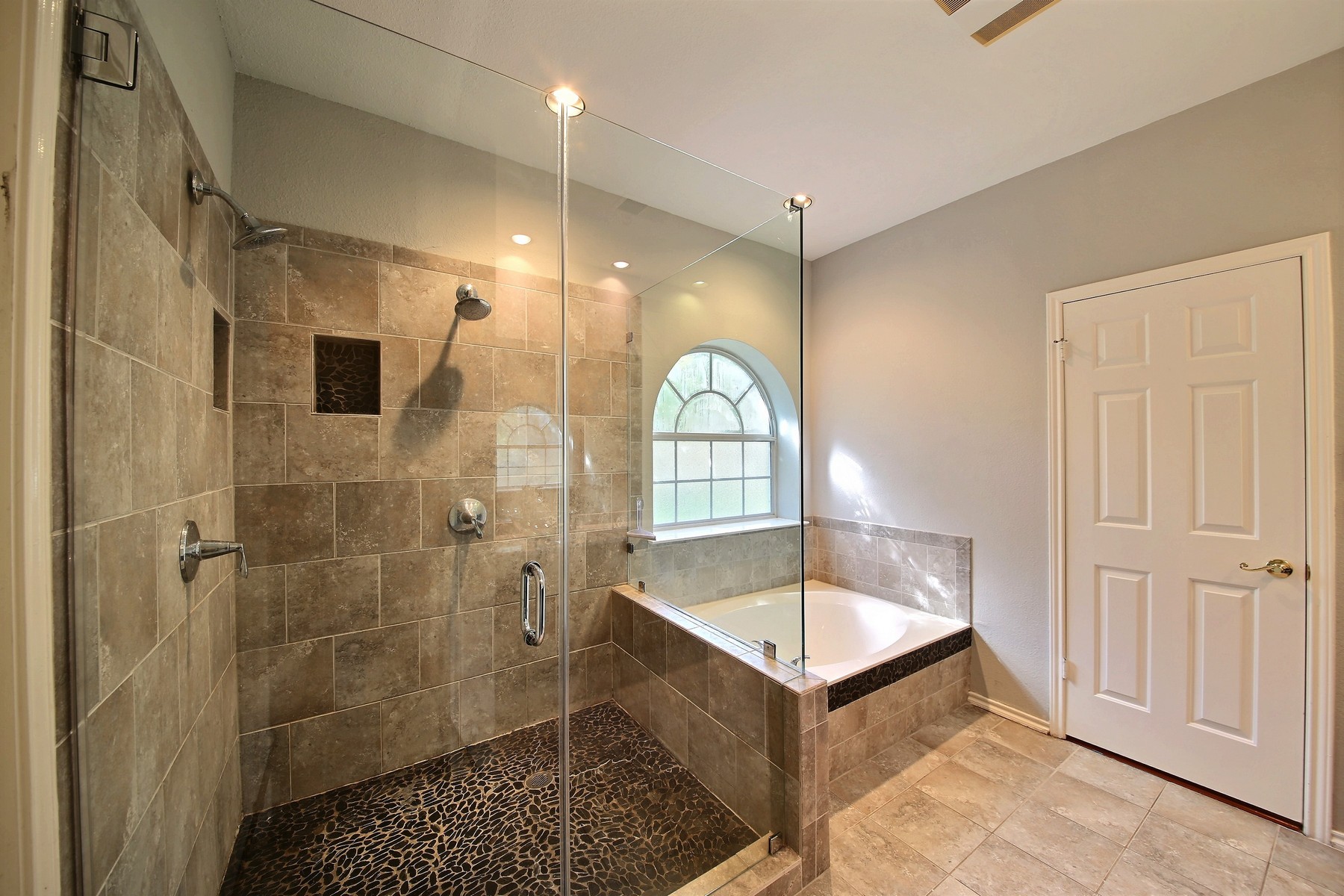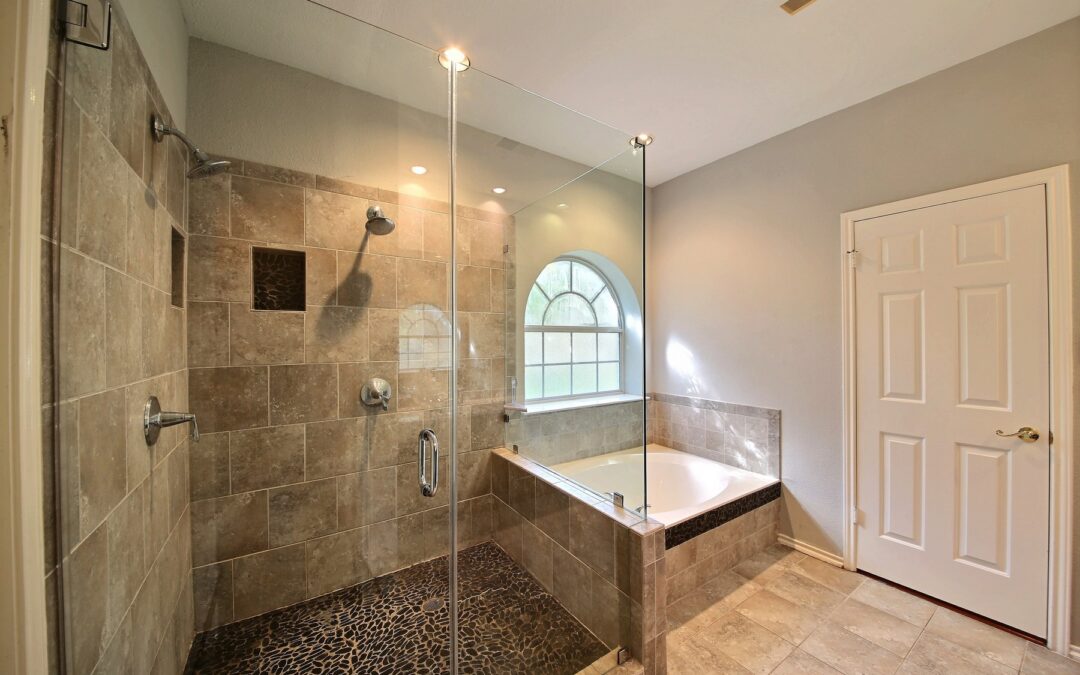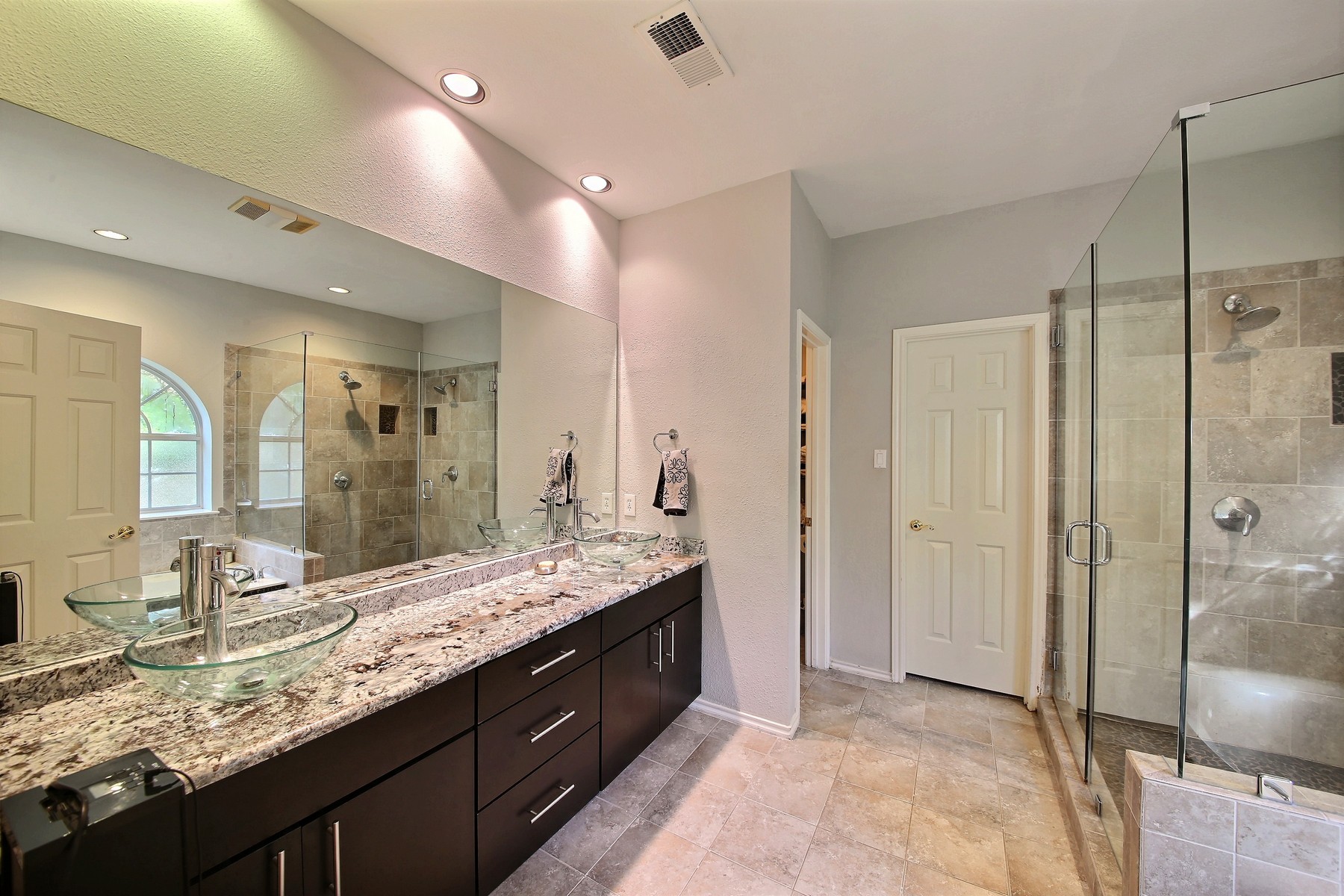
Bathroom Remodel included updating tub and shower tile, fixtures and seamless glass door. Also Installing matching tile flooring.
Want to save headaches on your next, or new, bathroom project? Follow some of our expert suggestions to help you with much of the nitty-gritty details, processes and options that go into making these decisions. Having this working knowledge of what to expect and what to consider can make the difference between a months-long waking nightmare or resulting in the room of your dreams.
At Renovate Paint and Design we can help guide your designs and selections and ensure a final product that you’ll be proud to have in your home. Give us a call for a free estimate/consultation: 210-403-3232. CLICK HERE to Check out our bathroom remodeling page on our website
Here are some tips for planning:
- Start with a Budget:
- Know what a bathroom remodel costs. Before you begin any project, it’s important to put your expectations into perspective when it comes to how much money you’re willing to invest. The size of your bathroom, the quality of materials you want to include can affect the cost of a remodel. A budget helps you set the boundaries of your design. Knowing what you can really afford to spend will make it a lot easier to decide what items you want to replace and where you need to get creative!
- Don’t want your budget to skyrocket? Don’t move your plumbing. On the surface, switching your sink and toilet around may look easy enough, but the problem lies underneath and all the costs involved in moving that plumbing. Besides, if you spend less money on moving fixtures, you’ll have more to spend on that new sleek shower system or vanity you’ve been eyeing.
- Don’t make the toilet the first thing you see when open the door. The reasoning is simple: when the bathroom doors is left open the focal point isn’t that which is not the most aesthetically pleasing thing to look at.
- Effective updating which can also be the easiest and the cheapest:
- Changing out all the hardware, such as drawer pulls, towel rods, faucet handles and shower heads, can make a big impact. Be sure to use the same finish, such as stainless steel, aged bronze or brushed nickel, to keep the room looking cohesive.
- Mirror Frame-Up: Dress up that builder-grade mirror with a fantastic frame, and at a fraction of the price of sourcing a huge hanging mirror.
- Punch It Up With Paint: Don’t underestimate the impact a pop of colorful paint can have in a small space. If you coordinate with a detail like your tile work, it can bring an entirely new dimension to your bathroom that you might never have noticed before
- Plan a lighting scheme. The best approach to a well-lit space is to incorporate layers of accent, ambient and decorative lighting. Sconce lighting at the vanity is the ideal way to get even lighting on your face and installing it at eye level will help diminish unflattering shadows. Dim lighting is nice for a relaxing bath; bright lights are great for shaving or applying makeup. Adding more overall lighting can make a small bathroom seem larger. Builder-grade lighting is one of the first things many people want to change in a bathroom renovation, and with good cause: The fixtures rarely hold much aesthetic appeal. Adding lots of light to a bathroom is one of the most valuable changes a homeowner can make
- Understand standard bathroom dimensions. Knowing a few key measurements, like the size of a typical bathtub and how much space is needed for a toilet, will help you plan your remodel more efficiently.
- Plan the right height for your sink. Typical countertops are 32 to 34 inches off the floor. But you need to consider how your sink will add to or take away from the countertop’s height. If you have an above-counter vessel sink, for example, you’ll want to make your counter height lower so you can wash your hands or brush your teeth comfortably.
- Consider a corner sink. If you’ve got a tight space with potential traffic-flow problems due to how the entry door or shower door swings open, then consider putting your sink in the corner to free up space.
- Pick the right vanity. Vanities aren’t just for looks. Get one too big and you could mess up your bathroom’s traffic routes. Too small and you’ll be scrambling for more countertop space and storage. Pick the wrong material and you could have maintenance issues on your hands.
- Splurge on a few high-end materials. A little designer secret is that because bathrooms are usually smaller spaces, splurging on a few higher-end materials and finishes can be a good investment that can make your space seem incredibly luxurious. So before you issue a mandate that your bathroom will feature only the most basic, affordable materials, look at materials for wall and floor coverings, countertops and more on the higher end of the spectrum. You might find that adding one or more of these materials to a small portion of your bathroom is within your budget. If your vanity is the main focal point of your bathroom, then choosing granite might not be such a splurge.
- Double check your tile size. Surprisingly, that 12-inch by 24-inch tile you bought might not be exactly what it claims to be. That’s because most tile is sold in European sizes (millimeters), and the quoted size might also factor in a grout joint, putting your fancy new tile at 11⅜, which can affect your tile layout, niches and plumbing.
- Think about converting your tub to a shower. If you don’t take baths but have a bathtub, that’s basically a 5-foot by 2½-foot area that’s going to waste. Converting it to a shower would be cost-effective, because it would make use of the space that’s already there and you wouldn’t have to reroute the plumbing. In addition, by removing the bathtub it makes for a larger space to turn that shower into one that you really want (walk-in style, Grecian shower-type, multiple shower heads, etc.).
- Have more than one way of drying out your bathroom. Reducing mold and mildew begins with removing moisture. To do that it’s best to have a multifaceted approach: a great fan that vents to the outside (not into an attic) and an operable window.
- Pay attention to how hardwood meets a tile floor. Chances are, your bathroom will have a tile floor, but the hallway or room it’s connected to will have something totally different, like hardwood. The transition between these two spaces and materials is something that’s tough to get right. As in most cases, planning ahead will give you results that meet your expectations. We never recommend hardwood floors or carpet in a bathroom. However, there are many tile options that have a hardwood look to them now.
- Going “green” is not only good for the environment; it’s also good for you. Green products have great design, tend to function better, which lowers utility bills, and they’re also chemical-free, making them better for your health. Having an eco-friendly approach to remodeling isn’t just about buying new products, doing something “green” can be as simple as painting a cabinet instead of tossing it in a landfill.



It was a useful tip when you told us to start with a budget when planning a bathroom remodeling to help set boundaries for the design. We had to deal with a mold problem at home last week, and while it has already been remediated, I don’t want the same thing to happen again so I’m considering giving our bathroom remodeling. I’ll keep this in mind while I look for a remodeling contractor to hire for the project soon.